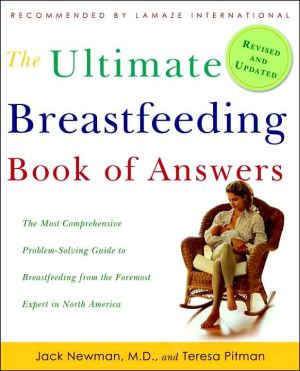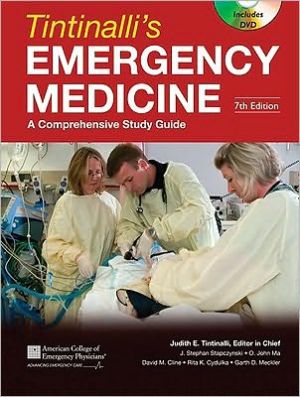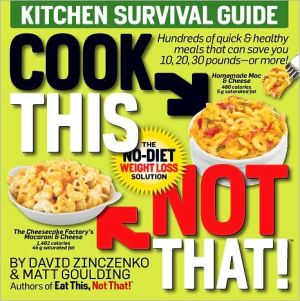The Ultimate Breastfeeding Book of Answers Revised and Updated: The Most Comprehensive Problem-Solving Guide to Breastfeeding from the Foremost Expert in North America
An Amazing Resource for Nursing Moms\ Although breastfeeding is the natural and healthy way to nourish your baby, it’s not always easy. Many new mothers are scared away from nursing because of difficulty getting started and lack of information about what to do when things don’t go as planned. In this fully revised and updated edition of The Ultimate Breastfeeding Book of Answers, two of today’s foremost lactation experts help new mothers overcome their fears, doubts, and practical concerns...
Search in google:
An Amazing Resource for Nursing MomsAlthough breastfeeding is the natural and healthy way to nourish your baby, it’s not always easy. Many new mothers are scared away from nursing because of difficulty getting started and lack of information about what to do when things don’t go as planned. In this fully revised and updated edition of The Ultimate Breastfeeding Book of Answers, two of today’s foremost lactation experts help new mothers overcome their fears, doubts, and practical concerns about one of the most special ways a mother can bond with her baby.In this comprehensive guide, Dr. Jack Newman, a leading authority on infant care, and Teresa Pitman, a La Leche League leader for more than twenty years, give you the facts about breastfeeding and provide solutions for the common problems that arise. Filled with the same practical advice that made the first edition a must-have for nursing moms, the new edition features updates on:• Achieving a good latch• What to do if your baby refuses the breast• Avoiding sore nipples• Ensuring your baby gets enough milk• Feeding a colicky baby• Breastfeeding premature and special-needs babies
1: Why Breastfeeding Is Important\ Myth: Infant formulas are pretty much the same as breastmilk, so it doesn’t make much difference which you choose.\ Fact: The risks to feeding a baby with anything other than the milk nature designed for him are real, and are a concern even in societies where medical care and treatment for the problems caused by these formulas are readily available. In some parts of the world, the use of breastmilk substitutes means many babies will very probably not survive. While the vast majority of bottle-fed babies in North America will survive, that doesn’t mean the health problems and risks are not real and potentially serious for both the individuals affected and the larger society that must help to care for them.\ Health care providers, childbirth educators, and others often talk about the “advantages” of breastfeeding. But to describe the differences between breastfeeding and artificial feeding this way includes the underlying assumption that artificial feeding is what is normal and acceptable, even though there may be some “fringe benefits” to breastfeeding.\ The warning messages on packages of cigarettes don’t say, “Non-smokers may have lower rates of heart disease or lung cancer,” they say, “Smoking increases your risk of heart disease and lung cancer.” That’s because we know that breathing in smoke-filled air is not normal or good for the human lungs.\ The different way we express this information is even clearer when we present statistics and percentages from research. If women who were breastfed as infants show (as they did in a recent study) a decrease of 25 percent in breast cancer rates when compared to women fed formula as infants, this can—more accurately—be restated this way: Women who were fed formula as infants had a 33.3 percent increase in breast cancer rates. Looks more significant, doesn’t it?\ It is breastfeeding that is the normal way to feed a baby. Breastfeeding is what the baby’s body and developing systems are designed to expect, and there are many factors involved in breastfeeding that are not yet fully understood. The important diVerence between the two methods of infant feeding is that there are risks to artificial feeding.\ One area of risk is in the manufacturer’s preparation of these breastmilk substitutes. As with any manufactured food item, there are sometimes mistakes in the composition of the food; contamination with bacteria and other material; and errors in the processing. There is a long history of formula recalls for various reasons—important ingredients left out, bacteria or other contaminants found in some cans, incorrect labeling and more.\ While these can happen with any food product, infant formulas are diVerent because they are the only food the baby gets for several months. If an important ingredient is missing (as has happened in the past), the effect on the baby can be serious. Babies have suVered brain damage and permanent developmental delays because of chloride-deficient formulas; babies have become ill with diseases such as meningitis from contaminated formulas. A recent study of several brands of formulas found that some cans contained more than four times the amount of Vitamin D listed on the label—and Vitamin D in excess is toxic. Choosing to use these substitutes for breastmilk means relying on a manufacturer’s assembly line, which will inevitably produce some errors and problems, and parents simply have to hope that their baby isn’t unlucky enough to get that batch of formula, and that they notice when a particular lot number is recalled.\ We often assume that if breastfeeding is not possible—a rare situation—formula is the second-best solution for feeding the baby. The World Health Organization (WHO), though, makes it very clear that infant formulas are not second best to breastfeeding. Second best would be the mother’s own milk, pumped or expressed, and fed to her baby (perhaps with a cup or tube). This is only second best because the value of breastfeeding includes such benefits as the development of the baby’s jaw and facial muscles as he nurses at the breast, and the transfer of germs back and forth between the mother and the baby, which helps protect the baby against infection and allergies, is more likely to occur when the mother and baby are together, touching, skin to skin and mouth to breast. Expressed milk won’t provide those important factors, but it is the next best thing to breastfeeding. If pumping or expressing is impossible, the third feeding suggestion on WHO’s list is donated milk from a breastmilk bank. Only if that is also unavailable would artificial baby-milk feedings be used—the fourth-best solution.\ But even the most complete, best prepared formula of any brand has significant risks when compared to “the real thing”—breastmilk.\ Let’s look at some of the areas that have been researched and consider the risks to babies fed artificially.\ Intelligence and Cognitive Development\ We know that the human baby’s brain is not yet fully developed at birth, and that it continues to grow and make important connections between the cells of the brain for about three years after birth. Once that process is completed, brain cells may die but no new ones can be added. Breastmilk, because it is designed for human babies, contains all the nutrients a baby’s brain needs to reach its maximum potential.\ Breastmilk substitutes (formulas), however, don’t have all these components. In fact, we don’t really know what all of them are.\ Researchers have known from early on that children who breastfed as infants scored, on average, higher on tests of intelligence and development, but researchers tended to attribute this to other factors. Perhaps mothers who chose to breastfeed were more motivated to do good things for their children, and this led to their being more involved in teaching their children as they grew up. Or perhaps the extra holding and skin-to-skin contact involved in breastfeeding was the reason these children were brighter, and mothers using breastmilk substitutes could achieve the same results by simply holding their babies more.\ Holding babies more and teaching them more are both good things. But a 1992 study tried to eliminate these factors by looking at premature babies who were being fed through a tube. Some of these babies were given their mothers’ milk, and some were given breastmilk substitutes—and the results were significant. When they reached school age, the children who had received breastmilk scored higher on tests of intelligence. The milk itself makes a diVerence.\ Other researchers have studied babies who were breastfed for varying lengths of time, and found that intelligence scores were higher (on average) for babies who were breastfed longer.\ It may be that the increased skin-to-skin contact and holding is also a factor. While mothers who are giving their babies formula will usually hold them during feedings when the babies are very small, once the baby is old enough to hold his own bottle, he is often set down in an infant seat to feed himself. As he gets older still, he’s likely to be given his bottle while sitting in a high chair or while walking around. A breastfeeding mother, on the other hand, always sits or lies down with her baby, to hold him on her lap or cuddle him beside her. This contact is undoubtedly beneficial to both of them.\ Diabetes\ Diabetes is a serious disease that is becoming increasingly common. Type I is the type seen in children, and there is clearly a genetic component that makes some children vulnerable to this illness. While the evidence is not conclusive, studies have shown that when formula or cow’s milk is not introduced to the baby’s diet until he is older (some have recommended waiting at least one year), the baby is less likely to develop diabetes.\ SIDS\ SIDS stands for Sudden Infant Death Syndrome—situations in which a baby dies, usually while asleep. This is also known as crib death or cot death. No cause for this syndrome has been discovered, and there are probably several factors involved. (After many years of advising parents always to put the baby to bed lying on his stomach, for example, doctors are now recommending that babies sleep on their backs to reduce the incidence of SIDS.) Researchers have found that feeding a baby with formula does increase the risk of the baby dying from SIDS.\ Respiratory Illnesses\ If you’ve noticed the steadily increasing numbers of children with asthma, you’re not alone. There are multiple causes of this problem, too (one being the increasing amount of air pollution in our cities, and another, the larger numbers of children in day care situations, where they are exposed to more viruses at an earlier age).\ Once again, though, feeding the baby with formula is a risk factor for developing asthma. Babies fed formula instead of breastmilk are also at a higher risk of other respiratory illnesses, including respiratory syncytial virus (RSV). They also take longer to recover from these illnesses than do breastfed babies.\ Ear Infections\ Since ear infections are quite common in infants and young children, this area has been frequently researched, and formula-feeding has been repeatedly shown to be a risk factor in developing otitis media (ear infection). Ear infections are often very painful for the baby, and can lead to further complications—fluid can stay in the ear for a period of time after the infection has been treated, aVecting the baby’s hearing and speech development.\ Childhood Cancer\ At least three studies have found that formula-feeding increases the risk of developing cancer during childhood. These studies are not conclusive, but there are good theoretical reasons why the conclusions may be correct.\ Gastrointestinal Infections and Diseases\ It seems logical that the baby’s gastrointestinal system would be aVected by the choice of infant feeding method—and it is. Formula significantly increases the baby’s risk of diarrhea caused by various infections, and babies who are fed artificially also take longer to recover from these illnesses. This is in part because they often have to be taken oV their formula and given only clear fluids while they are sick—meaning that they get fewer nutrients—while a breastfed baby can, and should, continue nursing and receiving high-quality nutrition plus antibodies to kill oV the germs that are causing the illness.\ Breastfed babies are much less likely to become constipated. In fact, their bowel movements are usually very loose, even if they become infrequent. Formula is much more likely to cause constipation and painful bowel movements.\ Effectiveness of Vaccines\ Artificial feeding reduces the eVectiveness of vaccinations by diminishing the baby’s response and production of the necessary antibodies. Breastfed babies have a better response to vaccinations, and produce more antibodies.\ Normal Development of Jaw and Facial Muscles\ Anyone who has carefully observed a baby suck on a bottle and compared it to the way a baby suckles at the breast knows that these are two very diVerent techniques. Naturally, they lead to diVerent development of muscles in the baby’s cheeks, jaw, and tongue. Some people claim they can recognize a breastfed baby on sight, just by looking for the rounded, well-developed cheeks! The importance of this becomes clear as the child gets older—children who were artificially fed as babies are more likely to need orthodontic work. Long-term breastfeeding, in particular, seems to promote the development of a well-shaped jaw and straight teeth.\ Other Conditions\ Artificial feeding increases the baby’s risk of many other problems as well. Several recent studies found that artificially fed babies are much more likely to become obese as children and teens. They are at greater risk of colitis, meningitis, Crohn’s disease, necrotizing enterocolitis, eczema, certain types of heart disease, and allergies, among others.\ Risks to the Mother\ Breastfeeding helps new mothers to recover from giving birth by encouraging the uterus to contract normally and by reducing the amount of blood loss.\ It also reduces the risk of developing breast cancer. Some early studies didn’t reveal this benefit; they tended to lump together women who had breastfed for only a few days with those who had breastfed for several years. Since then, more careful research has shown that the length of breastfeeding is important—the greater the total number of months of breastfeeding, the lower the risk of developing breast cancer. Myth: Breastfeeding is too diYcult and time-consuming for today’s mother.\ Fact: Breastfeeding is convenient, easy once you get the hang of it, and an enjoyable experience for most women.\ The topic of the first meeting in the standard La Leche League series of four meetings is Advantages of Breastfeeding. (Yes, they should probably change it to Risks of Artificial Feeding if they want to discuss the medical issues.) Often the leader of the group invites each mother to share the reason she thinks breastfeeding is important or valuable, and the discussion then flows around the room.\ Some mothers talk about how breastfeeding reduces allergies or ear infections. Some talk about the studies they’ve seen reported on how breastfed babies who are in day care stay healthier because of the extra antibodies, so the mothers will have to miss less work. Some might mention they hope to reduce their own risk of breast cancer.\ But they’re the minority. Most mothers talk about the emotional side of breastfeeding and how it makes mothering a baby, toddler, or young child easier and more enjoyable.\ They like the convenience: the milk is always ready, always at the right temperature. It takes just a second to lift up a shirt or undo a button and oVer the breast to the baby. They find breastfeeding easy when they’re traveling to places where it might be hard to store formula at the right temperature or find a place to heat it. They love being able to just roll over in bed and feed the baby when he fusses with hunger in the night. And they appreciate not having to spend time preparing or cleaning bottles, because it means extra time with the baby.\ Mothers often say it takes them a few weeks to really understand that breastfeeding is more than just another way of getting food into the baby. At first, they are focused on the mechanics of getting the baby to latch on properly and figuring out how much he is eating. But once those techniques are mastered, some of the other important aspects of breastfeeding become apparent.\ Breastfeeding is a great comfort to a baby who has been hurt or scared or upset for some other reason. It soothes a baby who has to be given a vaccination, and calms a baby who has been startled by a dog suddenly barking, or is stressed by being separated from his mother. It reminds the baby of being in the womb: “Ah, yes, there’s that familiar heartbeat, and that voice I’ve always heard, and that familiar smell, and I’m warm and comfortable,” and makes the transition to the outside world a little easier.\ Breastfeeding is a good thing for new mothers, too. Mothers at the meetings talk about how breastfeeding forces them to slow down in a busy world and spend time with their babies. You can’t prop up a breast and leave the baby to eat while you finish washing the dishes. Breastfeeding guarantees that you and baby will be skin to skin, relaxing together, several times a day. And those restful feeding times can be helpful in recovering from pregnancy and birth.\ They love the smell of the breastfed baby—that clean smell that doesn’t come from any soap or talcum powder. Even the baby’s bowel movements don’t smell unpleasant—they give oV that faint yeasty odor that warns you right before it all runs out of the diaper and down the baby’s leg.\ They talk about how breastfeeding tunes them in to their baby’s signals. Mothers tell stories about how they couldn’t consciously recognize their baby’s crying, but their breasts did, and started to leak milk at the sound of his voice. They talk about how often they wake up just a minute or so before the baby does. Some tell stories about how they knew their baby was ill because of a small change in the way he suckled or behaved at the breast.\ Mothers talk about how they learned, through the ongoing experience of breastfeeding, to understand the baby’s sometimes subtle cues. One mother was nursing her baby while chatting with a public health nurse. At some point during the conversation, the mother moved the baby to the other breast. The nurse stopped what she was saying and asked, “Why did you change breasts?” The mother, surprised, said, “He was finished that side, and he wanted the other one.” The nurse insisted that she hadn’t seen any signals from the baby. But the mother had felt the baby preparing to let go of the nipple, and without even thinking about it, moved the baby to oVer the other breast. These kinds of interaction become unconscious after a while. Experienced nursing mothers can tend to other children, prepare meals, talk with friends and still be aware of the baby’s suckling so that they know when to adjust the baby’s latch, when to change breasts, and when the feeding is over and the baby wants to be moved to another position.\ They will talk about the sheer pleasure of being skin to skin with their baby, and of seeing him drift oV to sleep at the breast with a trickle of milk running down his chin. As the baby gets older, and breastfeeding doesn’t take all the baby’s energy and concentration, he’ll begin to play at the breast, letting go to smile up at Mom, patting Mom’s cheek or investigating her dental work, making happy noises as he nurses. These are all part of the joy of parenting.\ “Taking a little one to nurse, watching him grow to manhood, that’s what love is.” —Carol Shields, The Stone Diaries\ Mothers who work outside the home talk about how much they appreciate that bond. It’s hard to leave your baby in someone else’s care, but being able to put the baby to the breast when you get home at the end of the day can re-establish the connection, and be relaxing for both mother and baby. These mothers like having something special between them and their babies—something the babysitter can’t do.\ These experiences are diYcult to measure in a scientific way, but they are very real to mothers, and they are important considerations in deciding whether to breastfeed or bottle-feed.\ Yes, It’s Worth Solving the Problems\ Twenty years ago, almost any diYculty encountered by a breastfeeding mother had a single solution: wean the baby. Sore nipples? Stop nursing. Breast infection? Wean immediately. Baby isn’t gaining weight well? Quit nursing. This probably seemed pretty easy and straightforward to the doctor giving out the advice, but it was often devastating to the mother who really wanted to breastfeed.\ If the baby was premature or smaller than average in size, even if born full term, the mother was usually advised not to even try breastfeeding, because suckling would be too hard for the baby, and breastmilk wouldn’t have enough calories to help him gain weight. If a baby was bigger than average, mothers were often told that their breastmilk wouldn’t be enough to sustain him, and that giving formula would be better. If either baby or mother had any health issues, breastfeeding would be stopped.\ Now mothers are more likely to be aware of the benefits and importance of breastfeeding, but may still have diYculty getting the help they need to make breastfeeding work.








